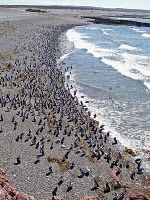SAO PAULO Hundreds of penguins that apparently starved to death are washing up on the beaches of Brazil, worrying scientists who are still investigating what’s causing them to die.About 500 of the black-and-white birds have been found just in the last 10 days on Peruibe, Praia Grande and Itanhaem beaches in Sao Paulo state, said Thiago do Nascimento, a biologist at the Peruibe Aquarium.Most were Magellan penguins migrating north from Argentina, Chile and the Falkland Islands in search of food in warmer waters.
 Many are not finding it: Autopsies done on several birds revealed their stomachs were entirely empty – indicating they likely starved to death, Nascimento said.Scientists are investigating whether strong currents and colder-than-normal waters have hurt populations of the species that make up the penguins’ diet, or whether human activity may be playing a role.”Overfishing may have made the fish and squid scarcer,” Nascimento said.Nascimento said it’s common for penguins to swim north this time of year. Inevitably, some get lost along the way or die from hunger or exhaustion, and end up on the Brazilian coast far from home.But not in such numbers – Nascimento said about 100 to 150 live penguins show up on the beach in an average year, and only 10 or so are dead.”What worries us this year,” he said, “is the absurdly high number of penguins that have appeared dead in a short period of time.”(AP)
Many are not finding it: Autopsies done on several birds revealed their stomachs were entirely empty – indicating they likely starved to death, Nascimento said.Scientists are investigating whether strong currents and colder-than-normal waters have hurt populations of the species that make up the penguins’ diet, or whether human activity may be playing a role.”Overfishing may have made the fish and squid scarcer,” Nascimento said.Nascimento said it’s common for penguins to swim north this time of year. Inevitably, some get lost along the way or die from hunger or exhaustion, and end up on the Brazilian coast far from home.But not in such numbers – Nascimento said about 100 to 150 live penguins show up on the beach in an average year, and only 10 or so are dead.”What worries us this year,” he said, “is the absurdly high number of penguins that have appeared dead in a short period of time.”(AP)
